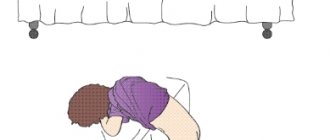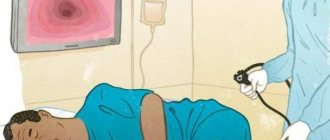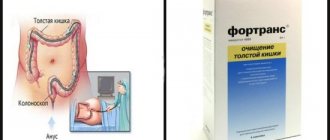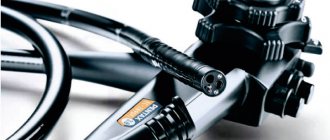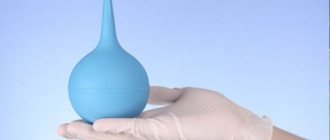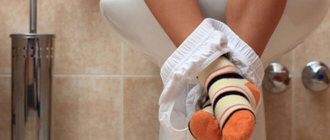Laxatives, medications that normalize intestinal microflora, diet, and physical activity can speed up bowel movements. However, it may take a long time for these methods to take effect. Laxatives and an enema (injection of liquid or medication into the rectum) can quickly relieve constipation.
Lactulose is allowed as a laxative for a newborn baby, and its effect is noticeable only the next day. To quickly empty the intestines, an enema may be recommended for the baby, the effect of which occurs within a few minutes. An enema for newborns for constipation should be recommended by the treating pediatrician.
Types and purposes
An enema (another name for the clyster procedure) can have therapeutic or diagnostic purposes. The following types of enemas are considered therapeutic:
- cleansing. They are indicated for constipation, when it is advisable to cleanse the rectum of feces and gases, or before medical procedures (surgery, x-rays of the abdominal organs);
- siphon. They are used if a cleansing enema does not produce results, and also if it is necessary to rinse the colon several times;
- laxatives. Indicated if dense stool has formed in the lower intestine. They are hypertonic, emulsion and oil;
- medicinal. They are done if it is necessary to administer local or systemic medications through the rectum;
- nutritious. They are intended for infusion of aqueous, saline solutions or glucose (nothing else is absorbed in the rectum or sigmoid colon). The procedure is done if swallowing is impaired, esophageal obstruction has developed, or in case of severe infections or intoxication.
A diagnostic enema is used to test the capacity of the lower tract and administer a contrast agent during studies.
Enemas can also be divided according to the amount of liquid infused:
- microenema (50–200 ml of liquid is poured into the intestines);
- macroclyster (1.5–12 liters of liquid are poured).
Fluid can be administered in two ways. Hydraulic assumes that the fluid comes from a container that is located above the patient. The injection method consists of introducing a product or water into the intestines using a syringe (bulb), Janet syringe or apparatus.
Enemas with vegetable oil
Oil is often used for enemas for children: it gently and safely relieves irritation and inflammation of the intestinal tube. Various oils are used: hemp, sunflower, vaseline. When placed in the intestines, healing of cracks and damage occurs.
The oil is used heated, a sufficient temperature is 37 degrees, slightly above normal body temperature. Inserted internally using a bulb. This is a preventative procedure. Consultation with a doctor is required.
When not to do an enema
All types of enemas are prohibited if the following pathologies are present (or the possibility of development cannot be excluded):
- bleeding in the stomach or intestines;
- acute pathological process in the lower digestive tract;
- inflammation in the anal area;
- malignant tumors in the rectum;
- acute inflammation of the appendix;
- seepage of pus into the abdominal cavity;
- bleeding from hemorrhoids;
- prolapse of a segment of the intestine.
Also, an absolute contraindication to an enema is recent surgery on the digestive organs.
Some experts speak out against enemas because they believe that their benefits for constipation are questionable
The negative consequences of frequent enemas are as follows:
- there is a pH shift in the large intestine;
- the natural intestinal microflora changes, which leads to the development of dysbiosis;
- the diameter of the rectum increases, muscles weaken;
- the intestines become “lazy” and the bowel reflex requires a stronger stimulus.
Therefore, an enema for a child with constipation is indicated only in exceptional cases, when bowel movements are difficult, and the baby cries, strains, and blushes during bowel movements.
MICROLAX® as an alternative to traditional enema
MICROLAX® laxative microenemas for newborns are designed specifically for children from the first days of life to 3 years. Thanks to a special shortened spout and a small amount of the drug contained in a disposable tube (5 ml), the enema procedure does not cause discomfort to the baby. This volume may be enough for a laxative effect, but not enough to provoke the urge to defecate due to irritation of the rectum.
Up to contents
The information in this article is for reference only and does not replace professional advice from a doctor. To make a diagnosis and prescribe treatment, consult a qualified specialist.
Indications
It is recommended to give a cleansing enema to a child who is constipated in order to soften the stool and free the lower intestine from feces and gases. The procedure is also performed in case of poisoning, before instrumental examination (for example, endoscopy, abdominal x-ray) or before surgery. It is also necessary to cleanse the intestines before administering a medicinal enema.
The liquid that is introduced into the intestines provides mechanical and thermal effects. The mechanical effect can be adjusted by controlling the amount of liquid injected, pressure and pressure. The higher the water container, the greater the pressure and the greater the impact. The level of intestinal peristalsis depends on the temperature of the water (the colder the liquid, the stronger the intestinal muscles contract and the faster the stool is pushed through).
It is usually recommended to make water for an enema slightly hotter than body temperature (37–39 oC), but if constipation in a child occurs due to intestinal atony, then a cold enema (12 oC) is used, and if the cause of coprostasis is spasms of smooth muscles, then it is necessary to do hot or warm enemas (37-42 oC). You can distinguish atonic constipation from spastic constipation by the nature of the stool: with atonic constipation, a fecal cylinder is released, but bowel movements occur every 2-4 days, and with spastic constipation, the stool is fragmented (“sheep feces”).
A properly done enema helps the child clear the intestines of gases and feces, stimulates motor skills, and relieves spasms.
In what cases should you give an enema?
It is recommended to give an enema to a newborn only as prescribed by a doctor. If this method is used incorrectly or inappropriately, it can cause more harm to the baby’s health than good. A cleansing enema may be prescribed if the child has occasional or persistent problems with bowel movements:
- lack of stool for several days;
- the child makes excessive efforts to defecate (strains heavily, grunts, etc.);
- the amount of feces is too small, and its consistency is dry and lumpy.
Up to contents
Technique
The pediatrician will tell you how much liquid to pour into the child’s intestines. Typically, an enema for a newborn or infant is done with a soft bulb and no more than 50 ml of water is poured in. For children aged 2 years, the recommended enema volume is 100 ml, and for children aged 3 – 200 ml. Children over 10 years old need a 500 ml enema. When the liquid is infused, the child should not feel pain in the abdomen.
Before doing an enema at home, you need to prepare a place for the procedure: cover the bed with oilcloth so that the end of the waterproof fabric is lowered into the basin standing in front of the bed (in case the child does not contract the sphincter), and lay a diaper on the oilcloth. Then the child should be placed on the edge of the bed (preferably on the left side) and asked to bend his knees and pull them towards his stomach.
To make the procedure painless, it is recommended that the patient completely relax and take deep breaths through the mouth.
Cleansing enema
For children 4 years of age, it is better to use a syringe with a soft tip for the procedure. You need to press the bulb and release all the air, then lower it into the water and collect the required amount. For a cleansing enema, an older child will need an Esmarch mug, which consists of a vessel with a volume of up to 2 liters, a rubber tube with a clearance of 1 cm and a length of 1.5 meters connecting tubes to control the flow of liquid and a rubber (glass, ebonite) tip.
This device can be purchased at a pharmacy. Pour water (up to 1.5 liters) of the required temperature into a container and place it approximately one meter above the bed. To release air from the tubes, you need to open the valve and drain some water. Apply Vaseline to the tip and insert it into the anus with a gentle rotational movement, then move it towards the navel by 3-4 cm, and along the spine by another 3 cm.
After the tube is inserted, you need to open the valve (the water should not flow quickly as this can cause pain). If the liquid does not flow, then you should change the position of the container or stick the tip out 10–20 mm. After the container is empty, you need to take out the tip and press one buttock to the other so that the water does not leak out.
If the child is older, you can ask him to independently squeeze the anal sphincter and hold the water (5-10 minutes). When the urge to defecate arises, you need to give a potty or sit on the toilet, and it is recommended that bowel movements be portioned. The procedure is considered ineffective if only water and a small amount of feces come out.
The procedure is performed for children over 5 years old using an Esmarch mug.
Siphon enema
A siphon enema is a rapid, repeated cleansing of the lower digestive tract. A rubber tube is inserted into the rectum, with a funnel at the other end. Liquid is poured into the funnel and raised 50 cm above the patient’s anus. When the water stops decreasing from the funnel, it is lowered so that it is lower than the patient and kept in this position until the water begins to pour out.
The funnel continues to be raised and lowered until clean water flows out of the intestines. Typically, a procedure for an adult requires 10–12 liters of water. Using a siphon enema, you can effectively cleanse the intestines of feces and gases. It can be prescribed to children who do not benefit from a cleansing enema, for example, due to prolonged constipation.
The procedure is also indicated for poisoning by toxins and in preparation for surgery. It cannot be done in severe conditions of the patient. The tip is inserted into the anus in a circular motion at a distance of 30–40 cm. During the procedure, when the funnel is at the top, there is no water in the mouth, since this will lead to the penetration of air into the tube (if air gets in, the siphon principle does not work, the tube must be entered again).
Most patients do not tolerate the procedure well, so you need to carefully monitor their condition.
Laxative enema
This procedure is effective for persistent constipation or intestinal spasms, when you cannot pour in a lot of liquid. A hypertensive enema provides effective bowel movement by allowing water to leak out of the intestinal wall. After the procedure, a large amount of water leaves the body (swelling decreases).
Vaseline oil for constipation and reviews about it
For infusion, a 10% saline solution, a 20–30% magnesium sulfate solution, or a 20–30% sodium sulfate solution can be used. The procedure will require 50–100 ml of a solution heated to 37–38 oC.
For the remedy to work, it must remain in the intestines for 20–30 minutes. An oil enema allows easy passage of stool, since the oil softens the stool and ensures its rapid movement through the intestines; in addition, it is not absorbed and relieves muscle spasm, thereby normalizing peristalsis. An oil enema is prescribed if there is spastic or prolonged coprostasis or chronic inflammation of the colon.
For the procedure, vegetable oil is used (you can take sunflower, flaxseed, olive) or Vaseline. So, 2-3 tablespoons of oil are added to 100-200 ml of water and heated to 37-38 oC in a water bath. In order for the remedy to work, it takes 10–12 hours, so the procedure is done at night and the patient is allowed to get up only after the urge to defecate appears.
Emulsion enema is prescribed for seriously ill patients. Its effect occurs within 20–30 minutes. An emulsion solution is used, which contains 400 ml of chamomile infusion, beaten yolk, a teaspoon of bicarbonate and two tablespoons of glycerin or petroleum jelly. The substance is drawn into the container, the remaining air is removed (you need to press until the liquid comes out). The narrow end of the bulb is lubricated with Vaseline, and then inserted into the anus 10–12 cm, after which the contents are slowly introduced.
Solutions for laxative enema are administered in a small volume, so the procedure will require a container of 50–100 ml (bulb or Janet syringe)
Medicinal enema
This enema can be given locally (the active ingredient helps eliminate irritation, inflammation or relieve spasms in the large intestine) or for systemic use so that the drug is absorbed into the bloodstream, bypassing the liver. For local treatment, as part of enemas, a decoction of chamomile, rose hips, sea buckthorn oil or an antiseptic.
Sedatives, painkillers, sleeping pills, NSAIDs, and anticonvulsants can be administered through the rectum. Half an hour before the medicinal enema, the patient must undergo a cleansing enema. The medicinal composition is heated in a water bath to 39–40 oC (if it is colder, the urge to defecate will occur), a total of about 50–100 ml is required.
To avoid irritation, the medicine can be administered with a saline solution, and a decoction of starch can be used to suppress bowel movements. After enema procedures, you should not get up for about an hour. An enema for children should be recommended by a doctor; it should not be given to an infant just because he has not had a bowel movement since yesterday.
This is an emergency measure that will help the baby get rid of pain, but in no case is it a treatment. To prevent constipation, you need to eliminate its cause, adjust the menu and monitor the amount of fluid your child drinks. In some cases, it may be necessary to take probiotics, antispasmodics, or other medications.
Carrying out enemas for children under one year old
Before administering an enema, the baby needs to make preparations.
Before giving an enema to a baby, you need to prepare for the process.
To do this, you need to use a pear, which is characterized by the presence of a rubber tip. Its volume can be 30-360 milliliters.
You will also need to use an Esmarch mug or rubber spray. Setting up an enema requires the use of boiled water or a solution at the required temperature.
To administer an enema, you must use Vaseline, baby cream or oil. You will also need a clean diaper or oilcloth. During the procedure, cotton pads or swabs are used.
Administration of an enema should only be carried out when the newborn child is calm. In order to sterilize the syringe, it is boiled for half an hour. Next you need to start preparing the solution.
Before carrying out the procedure, the mother is recommended to wash her hands thoroughly with soap. The procedure should be carried out on a changing table or couch, which is previously covered with oilcloth or a diaper.


